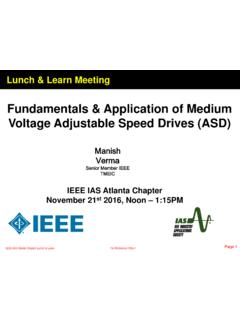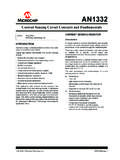Transcription of Fundamentals of Inverter–Fed Motors
1 Fundamentals of Inverter Fed MotorsTechnical Manual10/02MN780 Technical Manual 1MN780 ContentsPageThe Growing Use Of Inverters1.. How Inverters Affect Motors1.. Typical Problems2.. Suggested Solutions3.. ISR Inverter Spike Resistant3.. Lead Lengths3.. Load Reactors / Low Pass Filters4.. Design In Reliability4.. Select The Right Motor5.. Adjusting The Inverter6.. Installation6.. Conclusion6.. The Growing Use Of InvertersThe long standing desire to be able to adjust the speed of AC induction Motors electronically became areality in the early 1980 s.
2 Called Adjustable Speed Drives, Variable Frequency Drives or just Inverters, theycaught on quickly due to the many advantages they builders and plant engineers quickly saw the advantages of matching the machine s speed toprocess needs and variables. Modern drives can control starting currents, maintain precise set speeds,quickly change speeds, control reversing and quickly stop. This makes machinery of all types moreproductive, improves quality and more flexible with quick change over to run different materials with aminimum of downtime.
3 Multiple machines can be coordinated to have the right number of parts cometogether in the right place, and at the right great advantage is the potential for energy savings. Variable torque loads like fans and pumps thatvary their output by mechanical means can now adjust the motor s speed and reduce energy input by 25%to 50% with the simple addition of an inverter. They can also continuously adjust the speed to maintain adesired situation under varying system have taken their place in machinery of all kinds: metalworking, woodworking, chemical processing,water treatment, conveyors, heating, cooling, refrigeration, hoists, and just about every industrial orcommercial process.
4 The advantages are so obvious and numerous that today there are millions of them inuse and will continue to grow well into the next Inverters Affect MotorsEarly inverters caused significantly higher temperature rise in the motor, and mismatched could easily burnout the motor. As new transistor devices and software attempted to minimize this effect, they introducedother stresses on the motor s insulation system. It is time to design Motors specifically to operate on thesenew power sources. New IGBT, PWM inverters can output very high switching frequencies, very rapidchanges in voltage , and transient voltage spikes that can burn pin holes in the Motors insulation causingshort circuits and premature motor systems must be improved to prevent this cause of unscheduled and costly downtime.
5 Otherissues are increased motor noise and bearing failure. These pages address these issues and how tominimize these problems by proper equipment selection and application engineering. Burned Endturns Typical inverter spikedamage to motor in the first turn nearthe lamination stack. 2 Technical ManualMN780 Typical ProblemsSine WaveThe ideal power source and what inductionmotors were designed to run Frequency SwitchingPulse Width Modulation attempts to simulate a sinewave by firing many full voltage pulses in rapidsuccession.
6 To minimize noise, the frequency cansometimes be raised to 20,000 pulses per Rise TimeTo get higher modulation frequency, each pulse must bevery short and the inverter output goes from 0 volts to650 volts DC in one millionth of a second. This canseriously stress the motor s insulation than1 secondTransient voltage SpikesThis is what the motor sees as the voltage pulse from a PWMoutput enters the motor windings. Each rectangular pulse beginswith a spike of overvoltage nearly twice the DC bus voltage andthen settles down to the bus volts.
7 This High Potting can causepin holes in the motor s insulation turn to turn or phase to Wave VoltageAlso known as standing wave and voltage ring up. Some of theinverter output is reflected from the motor, back up the line towardthe inverter. If the distance and switching frequency are right, astanding wave forms. voltage from the inverter pulse and thereflected wave add together increasing voltage to the motor. Atlong distances a 460V RMS output can exceed 2000 volts at themotor HeatBasically, any portion of the waveform that is not a sine wave isconverted to heat in the windings.
8 This is more prevalent on theolder 6 step inverters but still can overheat or burn out somemotors even on PWM CurrentsThe high frequencies in the switching and transient spikes arealso induced into the rotor and build up a voltage potentialbetween the rotor and stator. This voltage is dissipated by arcingthrough the ball bearings. This continuous lightning storm will ruinthe finish in the bearing races and cause premature Manual 3MN780 Suggested SolutionsISR Inverter Spike ResistanttBaldor s Inverter Spike Resistantt wire has up to 100 times moreresistance to fast rising voltage spikes, and fast rise high frequencyinverter pulses as compared to standard wire.
9 This advanced feature isstandard on all Baldor Inverter DriveR and Vector DriveR Motors andall standard Motors 1hp and up. It is also available as an option oncustom Motors in most frame LengthsThe best installation will keep inverters and Motors close together. Theeffect of reflected wave voltage is generally not a problem if the powerrun is less than 15 feet (5 meters). However, as the run gets longer, voltage at the motor terminals rises higher than the insulation system sdesign voltage . One installation had 30 Motors driven from oneinverter.
10 Although the first motor saw 460 volts (RMS), the last motor,1000 feet of wire away saw 2000 volts. The best way to solve thisproblem is to not create it in the first place. Keep the run between aninverter and motor as short as applications require the motor and control to be separated by distance. In some plants the Motors can withstand harshenvironments, but the control cannot; therefore, forcing long distances between the MCC (Motor Control Center) and the often use one inverter to control multiple Motors placed along the length of the conveyor.











